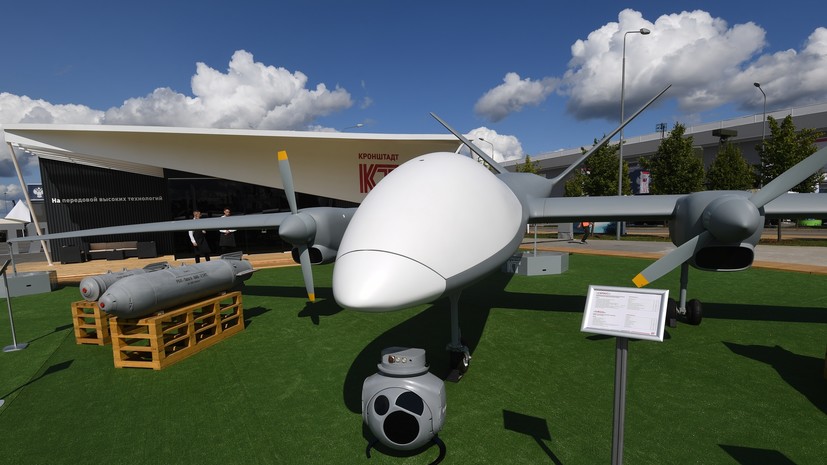The Sirius strike drone is being upgraded for the needs of the Russian Navy, where it will be able to perform the functions of a reconnaissance, search and rescue or anti-submarine weapon, as well as a repeater.
This was reported in the company "Kronstadt" - the manufacturer of the drone.
“Together with the naval aviation of the Russian Navy, research work is being carried out to determine the technical appearance of the modernized Sirius, designed to solve problems in the interests of the fleet.
An anti-submarine variant, a variant of a reconnaissance-target designator, search and rescue equipment and a repeater are supposed, ”TASS quotes a statement.
Earlier, on January 27, Russian Defense Minister Sergei Shoigu inspected the Kronstadt plant in Dubna, specially built for the production of large-sized UAVs.
As part of this trip, Commander-in-Chief of the Aerospace Forces, General of the Army Sergei Surovikin, informed the Minister of Defense of the Russian Federation that serial deliveries of Sirius attack drones to the troops would begin in 2023.
Surovikin also noted that the range of the new UAV is 3,000 km.
From Orion to Sirius
The strike and reconnaissance unmanned aircraft "Sirius" is a further stage in the development of the Orion devices.
For the first time, Sirius was demonstrated to the public at the MAKS-2019 air show in Zhukovsky in the form of a full-size model with a payload.
The UAV was also demonstrated at the Army-2020 international military-technical forum.
Outwardly, Sirius resembles the American MQ-1 Predator - a normal aerodynamic device with a thin fuselage, straight wing and V-tail.
The take-off weight of the device is 2.5 tons, the wingspan is 23 m. The Sirius is equipped with two turboprop engines with two-bladed propellers.
The payload of the new drone is 450 kg, the weight of the dropped cargo on the external sling is 300 kg.
At the Army-2020 forum, the new UAV was presented with a range of weapons that it can be equipped with.
Among them are corrected aerial bombs KAB-100, high-explosive aerial bombs FAB-100, free-fall bombs RBC-500U, volumetric detonating aerial bomb ODAB-500PMV and others.
In August 2021, Sergey Bogatikov, CEO of the Kronstadt developer company, announced that Sirius would become the carrier of the unified communications, data exchange, navigation and identification system (OSNOD).
Its equipment is designed for encoding and decoding information, transmitting large amounts of data and positioning an aircraft in the absence or suppression of GLONASS signals.
“The main difference is that Sirius was built as a heavier version of Orion with satellite control and the ability to interact with manned aircraft, that is, it was originally provided for the installation of OSNOD equipment,” Bogatikov said.
This system has increased crypto- and jamming protection and was tested in 2019 on fifth-generation Su-57 fighters.
According to the developers of the NPP Polet system, special types of noise protection and noise-correcting coding with information recovery are implemented in it.
It also provides constant cryptographic protection of communication, which makes it useless to intercept its messages.
OSNOD is designed to provide real-time control of various types of aircraft during combat operations.
The terminals of this system can be installed on airplanes and helicopters, warships, ground mobile and stationary objects.
To mass production
Earlier, during the visit of the head of the Russian Defense Ministry Sergei Shoigu to the plant in Dubna, the general director of Kronstadt Sergei Bogatikov said that the first flight of the Sirius was scheduled for May 2022.
“The issue of RKD (working design documentation) has been fully completed.
Flight prototypes are currently under production.
We are making our first flight in May of this year.
We are finishing flight tests at the end of this year,” Bogatikova said.
The general director of Kronstadt added that in parallel with the production of prototypes, preparations are underway for the serial production of Sirius.
The founder of the Military Russia portal, Dmitry Kornev, in a conversation with RT, noted that the new strike and reconnaissance drone will be in demand by the Russian Navy as well as the Aerospace Forces and the Ground Forces.
“Such a device will be able to perform both observational and combat missions.
Thanks to a larger supply of fuel, it will be able to operate at a sufficiently large distance from the coast, we can talk about a range of thousands of kilometers from coastal bases.
For the Russian fleet, this would be a rather unique and highly demanded tool, especially for combating submarines, ”the expert said.
Improved performance will help Sirius cover a larger area of the world's oceans, Dmitry Kornev added.
“At the same time, we will not risk crews and more expensive manned anti-submarine reconnaissance and combat aircraft.
This will seriously save resources to cover a larger area when performing tasks to detect submarines, ”the RT interlocutor emphasized.
In turn, the doctor of military sciences, retired captain of the first rank Konstantin Sivkov noted that the Sirius will surpass foreign analogues in its characteristics, for example, the American Global Hawk drone.
Significantly increased range and flight time will allow it to perform a wide range of tasks in the Russian Navy, the expert added.
“UAVs with a high flight time can provide constant patrols around ships at a distance and help in the use of preemptive missile weapons.
In addition, it will be possible to place, albeit in small numbers, sonar buoys on it and collect information about the location of foreign submarines in large water areas, ”Konstantin Sivkov said in a comment to RT.
In addition, drones can also be armed with small-sized torpedoes, which will allow them to attack submarines directly, the expert added.
“Thus, favorable conditions are created for constant anti-submarine surveillance in coastal seas ... This, of course, will be a very serious contribution to ensuring the combat capabilities of the Russian Navy.
And when these drones are introduced on a massive scale, it will be a breakthrough.
This will radically increase the capabilities of the fleet, ”concluded Sivkov.

